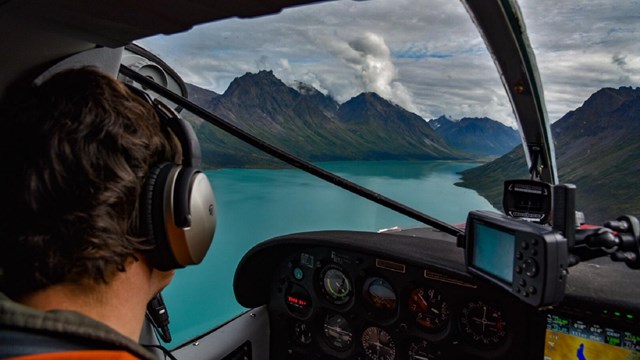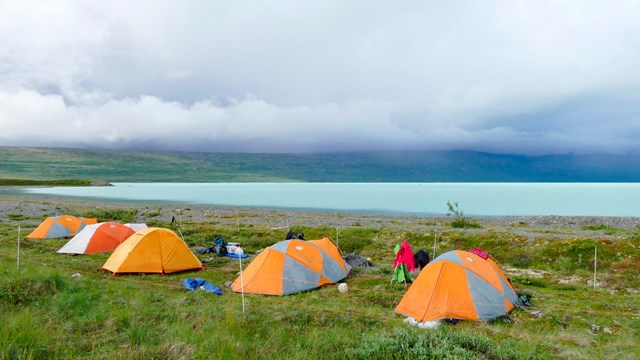|
A camping trip into Lake Clark's trail-less wilderness can be a spectacular and rewarding experience. Thorough preparation and careful trip planning will help ensure you have a safe and meaningful trip. Here you will experience undeveloped wilderness, self-reliance, and solitude to an extent seldom found elsewhere. Base camping, backpacking, and hiking options are abound in the park and preserve. While the only developed and maintained trails in the park are part of the Tanalian Trails network near park headquarters in Port Alsworth, hiking is allowed anywhere not otherwise closed to public use. Lake shores, coastal beaches, and high tundra are excellent areas for that activity. Adventurers in Lake Clark will need to rely upon their way-finding and hiking skills, or hire a guide who can help them. Thorough research and preparation will be important in creating your own safe adventure in Lake Clark National Park and Preserve. Backcountry Pro-TipsBackpacking in AlaskaWilderness TravelLake Clark National Park and Preserve is a trail-less wilderness, and you are free to travel where you like. Off-trail hiking employs the senses, heightens awareness and actively requires your constant participation in making decisions. You'll hike cross country, using a map and the lay of the land to get where you want to go. There are rivers to ford, bogs to avoid, and bad weather to sit out. Vegetation and terrain usually dictate the difficulty of the hiking. Plan on covering one mile per hour (allowing for errors in navigation, route selection and tough going). If you're not familiar with Alaskan terrain, be prepared to turn back and try a different route, and give yourself plenty of time to get where you're going. Keep in mind that all streams and rivers must be forded, and during high water levels, this may be impossible. All camping is primitive, no facilities or designated campsites exist. You should use Leave No Trace guidelines to minimize your impacts. Backcountry permits for camping and hiking are not required, however there are rules and regulations governing one's behavior in all national park areas. Please do not take, shape or alter the wilderness around you. 
Meanings of Dena’ina Tinitun (Trails)
The cultural value of tinitun (trails) have deep, multilayered meanings and uses in inland Dena’ina tradition. 
Camping Along the Cook Inlet Coast
Campers should be extra vigilant with food storage and plan for safe camping in bear country. 
Fishtrap Lake to Snipe Lake Route
Backpackers willing to navigate extremely dense brush at lower elevations will reach secluded alpine tundra with endless ridgelines. 
Hope Creek Route
Explore some of Dick Proenneke's stomping grounds by hiking into the valley above his cabin at Upper Twin Lake. 
Low Pass Route
Backpackers on this route will explore more of Dick Proenneke's stomping grounds in the high country above Upper Twin Lake. 
Telaquana Route
This popular backpacking journey follows a ancestral Dena'ina Athabascan route between Kijik Village on Lake Clark and Telaquana Lake. 
Upper to Lower Twin Lakes Route
Explore some of Dick Proenneke's favorite spots by walking the shoreline between Upper and Lower Twin Lakes. 
Aviation Safety
Most visitors travel to Lake Clark via small plane. Safety in this remote place depends on more than just a pilot's skill. Staying SafeBoth black and brown bears live in Lake Clark. It is critical to educate yourself about safe practices in bear country and be prepared to handle a potential bear encounter. Read up on bear safety before starting your trip. Lake Clark is exceptionally remote and isolated. Caution, good judgment and thorough preparation will help ensure you have a fun, safe trip. Please always tell someone where you are going and when you will return. While it is not required, it is a good idea to also leave your trip itinerary with us at our visitor center in Port Alsworth before departing into the backcountry. If we get a call indicating you are overdue it makes it easier to help you. CampsitesLake Clark National Park and Preserve is primarily a trail free wilderness where travelers may camp where they like. There is a camping area near Hope Creek on Upper Twin Lake just west of the Proenneke Historic Site. Tulchina Adventures offers rustic camping in Port Alsworth. 
Gear Rental and Guide Services
Want a guide? Need access to equipment? Find providers here. 
Lake Clark's Food Storage Requirements
Know how to properly store your food, toiletries, and fish prior to arriving in Lake Clark. 
Staying Safe in Bear Country
Bears and people use the same areas in Lake Clark. Become familiar with these tips for staying safe in bear country prior to your trip. 
Getting to Lake Clark
Visiting Lake Clark can be challenging. You cannot drive because the park is not on the road system. Instead, you must fly or take a boat. 
Park Maps
How to obtain Lake Clark maps from the park, USGS, or our partners. |
Last updated: October 20, 2021
